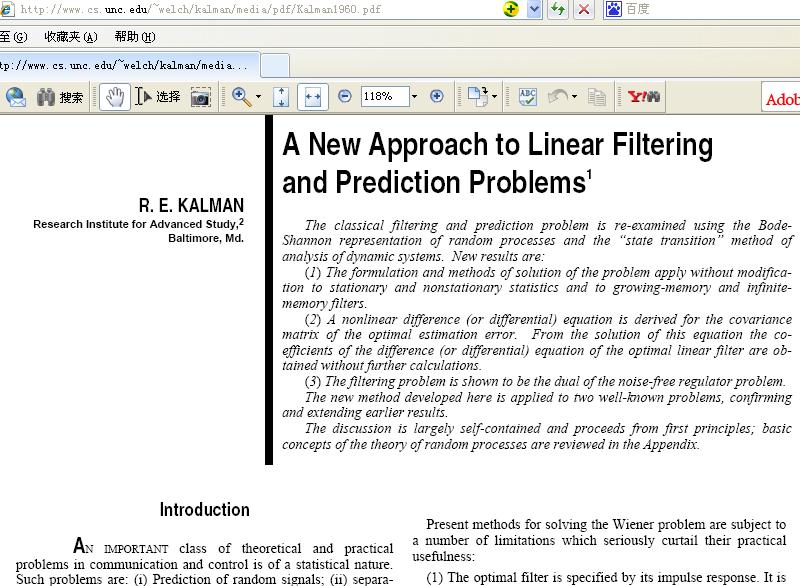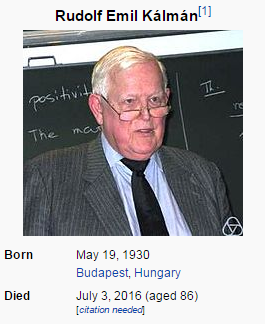博文
“卡尔曼滤波”掌门人近日退隐苍穹、控门绝技系由何毓琦先生命名
||
说明:本文目的不是质疑,而是对何先生与卡尔曼先生的长期学术交往及在卡尔曼推出新滤波方法之初就认识其重要意义与率先命名的赞扬。何先生在几篇博文中介绍了卡尔曼的成就及他与卡尔曼的交往。(http://blog.sciencenet.cn/blog-1565-988496.html)
本人作为一个水文、气候统计从业者,卡尔曼滤波作为一种行之有效的信号处理方法已是常见之语。比如,1979年发表于《水利水电技术》的《卡尔曼滤波在水文学和水力学中的应用》一文摘要称:“1978年10月初,美国河工考察团来我国访问。访问期间,曾在水利水电科学研究院座谈了水利水电科技方面的新动向。这里刊登的是美籍科学家邱照淋教授关于“卡尔曼滤波理论在水文学和水力学中的应用”的简介。卡尔曼滤波是一种新的数理估计方法,早在1960年即已提出,并在宇航与自动控制方面获得较广泛的应用,1970年以后,在水利水电科学技术中也开始有所应用。这是水文学和水力学研究中的一个新动向,特发表供有关部门及科研人员参考。”
不过,我是个门外汉,对于自动控制理论以及卡尔曼先生的线性控制理论基本上没有了解,出于好奇,厚厚的自动控制旧教材倒是买过一本,可惜只是临时装点过书架。
卡尔曼先生不久前仙逝而去,国内外网页都有一些报道与怀念文字。
关于卡尔曼先生创造的“卡尔曼滤波”方法或理论的得名,中外网页多一语带过。比如,有中文网页介绍:“最佳线性滤波理论起源于40年代美国科学家Wiener和前苏联科学家Kолмогоров等人的研究工作,后人统称为维纳滤波理论。从理论上说,维纳滤波的最大缺点是必须用到无限过去的数据,不适用于实时处理。为了克服这一缺点,60年代Kalman把状态空间模型引入滤波理论,并导出了一套递推估计算法,后人称之为卡尔曼滤波理论。”(http://wiki.mbalib.com/wiki/%E5%8D%A1%E5%B0%94%E6%9B%BC%E6%BB%A4%E6%B3%A2)
英文维基“https://en.wikipedia.org/wiki/Kalman_filter”介绍,“The filter is named after Hungarian émigré Rudolf E. Kálmán, although Thorvald Nicolai Thiele[3][4] and Peter Swerling developed a similar algorithm earlier. Richard S. Bucy of the University of Southern California contributed to the theory, leading to it often being called the Kalman–Bucy filter. Stanley F. Schmidt is generally credited with developing the first implementation of a Kalman filter.”
中文维基“卡尔曼滤波”称(注:无法直接访问,据转载消息),这种滤波方法以它的发明者鲁道夫.E.卡尔曼(Rudolph E. Kalman)命名,但是根据文献可知实际上Peter Swerling在更早之前就提出了一种类似的算法。斯坦利.施密特(Stanley Schmidt)首次实现了卡尔曼滤波器。卡尔曼在NASA埃姆斯研究中心访问时,发现他的方法对于解决阿波罗计划的轨道预测很有用,后来阿波罗飞船的导航电脑便使用了这种滤波器。关于这种滤波器的论文由Swerling(1958)、Kalman (1960)与Kalman and Bucy(1961)发表。
中、英文维基对比,可以发现英文词条中又增加了一位提出类似方法的更早的研究者Thorvald Nicolai Thiele(1838-1910)。下面摘录卡尔曼先生1960年论文片段(见于http://www.cs.unc.edu/~welch/kalman/media/pdf/Kalman1960.pdf ):


据科学网博主、与卡尔曼先生有过长期交往与合作的控制华裔控制专家何毓琦先生介绍,“卡尔曼滤波法”可能是由他最早命名的。我觉得这是一个有趣的佳话。 何毓琦先生对他与卡尔曼先生的交往在他的博文中也有一些介绍。据何老回忆:“Subsequently during my stay at RIAS (Kalman’s place of work at that time) for six weeks in 1962, I became one of the very early fan and proponent of his greatest contribution, the Kalman filter, a moniker which I named.随后在1962年,在卡尔曼那时工作的地方RIAS (注马丁公司的高等研究院),我访问他并逗留了六周,这使得我成为他伟大贡献的最早粉丝和支持者之一,那个被后世称为卡尔曼的滤波器,就是出自本人之口来命名的。”(http://blog.sciencenet.cn/blog-1565-988496.html)(注:中文由科学网博主谢力翻译)
可以判断,何老在卡尔曼提出新滤波方法之初,就已看出卡尔曼滤波的潜在价值与重大意义,率先将卡尔曼论文中的滤波新技术直接用卡尔曼的名称命名,使之与维纳滤波在名称上并驾齐驱,宣传并扩大了卡尔曼滤波的影响。
知乎网站的网友“小心假设”提到(http://www.zhihu.com/question/23971601):‘如何通俗并尽可能详细解释卡尔曼滤波?’个人觉得何毓琦老师(曾与Kalman合作,何老博客里有不少介绍)的这篇博文讲得算是非常好了,虽然仍有公式。http://blog.sciencenet.cn/blog-1565-14253.html”。
科学网博主应行仁先生在博文《我遭遇恶老师和自己当恶老师》中写道:“当年卡尔曼发表他的滤波技术论文时,数学证明是错的,但卡尔曼滤波却成了随机控制最重要的结果。”(http://blog.sciencenet.cn/home.php?mod=space&uid=826653&do=blog&id=799745)。应先生所言的情况我不太清楚,尚没有做进一步检索。
据科学网博主王守业的博文《当选为美国工程院院院士的6位中国大陆留学生》(http://blog.sciencenet.cn/home.php?mod=space&uid=563591&do=blog&quickforward=1&id=449003)介绍, 科学网知名博主:何毓琦(英文名:Yu-Chi "Larry" Ho),据中英文维基百科介绍:何毓琦1934年出生于中国上海,于1949年(15岁)时离开上海前往香港并在香港完成高中教育。1950年,他被麻省理工录取(16岁),并在1953年(19岁)拿到电子工程学位,1955年拿到电子工程硕士学位。在Bendix Aviation工作三年之后,他接着进入麻省理工攻读博士,并于1961年拿到应用数学的博士学位。1987年当选为美国工程院院士,何先生是世界知名的美籍华人数学家、控制理论家,哈佛大学、清华大学教授(2001年起清华讲座教授)。中国科学院及中国工程院外籍院士。他于2007年4月25日在科学网开通博客,分享科研经验与人生感悟(基本是纯英文博文)。根据他的博客介绍,在总共四十多年的学术生涯中,他和妻子一起去过了《一生中要去的一千个地方》中的200多个。有兴趣的可点击参见其博客。据我了解:何毓琦先生是美国工程院院士中唯一的一位在科学网开博的,并且是仅有的几位用英文写博文的博主。
在何老博文《On being elected IFAC Fellow》(http://blog.sciencenet.cn/blog-1565-990720.html)之后的点评中,一匿名网友crossing提议(2016-7-16 01:59):“何教授应该写一本自传,用中文出版最好。华人社会有您这样成就的屈指可数。”,何老回复:“Yes, I thought about it. But it is a very big undertaking and I am hesitant to start. Writing short autobiographical blog pieces are much easier .”。这个提议确实是个好想法,希望何老将来能够拨冗或者请年轻人协助,把自己的切身经历与体会进行比较系统的归纳。 ”
附1:http://blog.sciencenet.cn/blog-1565-988496.html
Rudolf Kalman of Kalman Filter fame passed away yesterday
2016-7-4 何毓琦
何毓琦先生关于卡尔曼去世悼念之译(何先生原文为英文,由谢力翻译为中文)
我刚刚得知一个悲哀的消息,卡尔曼,系统和控制的巨人,昨天去世了。稍后会有更多的细节通报,尽我所知吧。卡尔曼享年86岁。 何毓琦
以下注记加于2016年7月5日(美国东部时间)
到目前为止,维基百科对他的过世只有极少的报道。就个人而言,卡尔曼在我个人职业生涯中,发挥了很大作用。他的早期工作对我博士论文有巨大影响(http://blog.sciencenet.cn/blog-1565-250198.html),这包括我们唯一的共同工作:可控性研究。
随后在1962年,在卡尔曼那时工作的地方RIAS (注马丁公司的高等研究院),我访问他并逗留了六周,这使得我成为他伟大贡献的最早粉丝和支持者之一,那个被后世称为卡尔曼的滤波器,就是出自本人之口来命名的。通过贝叶斯观点,我给出的、对他工作详尽的报告和其他辅导材料 (http://blog.sciencenet.cn/blog-1565-851754.html) 有助于解释他的系统性方法并使之风行。事实上,卡尔曼本人感谢我的努力,他在德雷珀奖获奖演说中明确地致谢于我 (http://blog.sciencenet.cn/blog-1565-16065.html )。
当然,1964年,如果他不接受来自于斯坦福的工作机会,而是就职于哈佛,那么我在哈佛的终身教职晋升实际上或许没有机会。
人们也可以说我欠他一个终身教职(但那是彼时的另一个故事了)。卡尔曼难得胡涂,时常公开批评其他人的工作,这被人津津乐道。然而一直以来,我和他保持着亲切友好的关系。他的逝世不仅是个人损失,也令人悲哀地想到:系统和控制的一个黄金时代已随其而去。
附2:https://en.wikipedia.org/wiki/Kalman_filter Kalman filtering, also known as linear quadratic estimation (LQE), is an algorithm that uses a series of measurements observed over time, containing statistical noise and other inaccuracies, and produces estimates of unknown variables that tend to be more precise than those based on a single measurement alone, by using Bayesian inference and estimating a joint probability distribution over the variables for each timeframe. The filter is named after Rudolf E. Kálmán, one of the primary developers of its theory.
附3:http://www.08kan.com/gwk/MzA4ODcwOTExMQ/2655575672/1/01de8f359d247915b675256b747d9bba.html
http://mt.sohu.com/20160711/n458751113.shtml
缅怀:一代宗师卡尔曼
中国指挥与控制学会 2016-07-11
导读:卡尔曼,一位划时代的大师!一位成就了无数人的智者,一座很难超越的里程碑。他提出了系统的能控性和能观性,为控制理论的出现奠定了坚实的基础。这位匈牙利裔美国数学家提出的卡尔曼滤波,颠覆了通信,导航,制导与控制等多个领域,这对现代科技的发展无疑是巨大的。2016年7月2日,这位巨人陨落了,今天就让我们回顾一下这位传奇人物的一生,再次走近他终其一生所追求的数学世界!
2016年7月2日凌晨,一代宗师卡尔曼与世长辞,享年86岁。
大师的一生
--------------------------------------------------------------------------------
鲁道夫·卡尔曼(Rudolf Kalman),1930年5月19日出生于匈牙利首都布达佩斯,父亲是一位电气工程师,后来跟随父亲的脚步,移居美国并在麻省理工学院获得电气工程学士和硕士学位。之后,他又离开了麻省理工学院,前往哥伦比亚大学继续从事研究,并获得了哥伦比亚大学博士学位。(也曾是少年)
卡尔曼早期在麻省理工学院和哥伦比亚大学对控制系统充满了兴趣。他早期的研究主要是从实际问题出发,对状态变量表示概念的研究,这种研究在数学上很先进。他曾表示,早期的研究方法非常个性化,却在他后续辉煌的职业生涯中发挥了很大作用。
从1957到1958年,卡尔曼任职于纽约波基普西的IBM研究实验室。在纽约那段时间里,他对线性数据采样控制系统采用二次型性能标准的设计和控制系统分析与设计的Lyapunov理论的运用方面做出了重大贡献。当时,他已经预见到大规模数字计算机系统的重要性。
1958年,卡尔曼加入由已故的Solomon Lefschetz创办的RIAS(the Research Institute for Advanced Study)研究所。刚开始,他是作为一个数学研究人员,后来晋升为副主任。正是在那段时间(1958-1964),他在现代控制理论方面做出了开拓性贡献。他的演讲和出版物反映了他的巨大创造力和控制理论方面研究工作。他在基本系统概念的研究,如可控性和可观性方面,为一些重要的工程系统奠定了坚实的理论基础。他统一了离散时间和连续时间情况下线性系统的理论和设计方面的二次标准。为引入Caratheodory到最优控制理论,他做出了很多贡献,并阐明了Caratheodory、庞特里亚金(Pontryagin)最大值原理和哈密尔顿-雅可比-Bellman方程之间的关系,以及一般的变分法。
他的研究不仅强调数学的一般性,还将数字计算机作为设计过程的组成部分和控制系统实现的组成部分进行综合考虑。
在RIAS期间,卡尔曼做出了他一生中最著名的贡献,也就是所谓的“卡尔曼滤波”。1958年底到1959年初期间,他在离散时间(采样数据)问题方面取得了一些成果,并将早期的基础工作应用在维纳滤波、Kolmogorov、伯德、香农、普加乔夫和其他现代状态空间方法上。他对离散问题的研究自然而然地将他引向连续时间问题,并于1960-1961年期间与R.S.布西共同提出了“连续时间Kalman滤波器”。
……(以下略)
附4:http://www.zhihu.com/question/23971601
如何通俗并尽可能详细解释卡尔曼滤波?
网友:小心假设
个人觉得何毓琦老师(曾与Kalman合作,何老博客里有不少介绍)的这篇博文讲得算是非常好了,虽然仍有公式。http://blog.sciencenet.cn/blog-1565-14253.html
附5:http://carpa.bokee.com/4725695.html
卡尔曼全名Rudolf Emil Kalman,匈牙利数学家,1930年出生于匈牙利首都布达佩斯。1953,1954年于麻省理工学院分别获得电机工程学士及硕士学位。1957年于哥伦比亚大学获得博士学位。我们现在要学习的卡尔曼滤波器,正是源于他的博士论文和1960年发表的论文《A New Approach to Linear Filtering and Prediction Problems》(线性滤波与预测问题的新方法)。如果对这编论文有兴趣(陈昌春注:应是“这篇文献”),可以到这里的地址下载: http://www.cs.unc.edu/~welch/kalman/media/pdf/Kalman1960.pdf
简单来说,卡尔曼滤波器是一个“optimal recursive data processing algorithm(最优化自回归数据处理算法)”。对于解决很大部分的问题,他是最优,效率最高甚至是最有用的。他的广泛应用已经超过30年,包括机器人导航,控制,传感器数据融合甚至在军事方面的雷达系统以及导弹追踪等等。近年来更被应用于计算机图像处理,例如头脸识别,图像分割,图像边缘检测等等。
卡尔曼滤波器的介绍(Introduction to the Kalman Filter)
……下略
Proximity to Fame (#2) The Draper Prize (Nobel for Engineering) for 2008
– the Kalman Filter : a technical explanation and personal account of its history
I must be prescient. In my June 21, 2007 blog article : On Prizes, Nobel and others, http://sciencenet.cn/blog/user_content.aspx?id=3574
I predicted that Dr. Rudolf E. Kalman should win the Draper Prize given by the National Academy of Engineering (NAE) of the US sometimes in the future. Little did I know that my prediction became true almost immediately as announced today by the US National Academy of Engineering. Kalman filter arguably is the crowning achievement of modern system and control theory. It is behind almost every aerospace guidance and control systems, the ubiquitous GPS unit in most automobiles and everywhere else, and countless industrial applications. Yet its principle goes way back to the least square method of Gauss, the famous mathematician of 18th century, and the ancient civil engineering method of triangulation for position determination. Except the Kalman filter takes this principle to such a sophisticated degree that even today most students who learn about the Kalman filter are unaware of this fundamental connection. ……(详见何先生博文)
附7:http://blog.sciencenet.cn/home.php?mod=space&uid=687793&do=blog&id=612378
与国内师生谈科研输出4:作学术报告四建议
李晓榕
比如有一次我在一个国际专业大会上,指出卡尔曼滤波的种种局限,并报告我对它的重要拓展和推广,为了加深印象,我在结束时故意“危言耸听”地问:既然有我的结果,是否应该禁止使用卡尔曼滤波?会后有位学者很严肃地对我表示“抗议”,在场的另一位知名朋友解释说我这是夸张,他还不接受。还应对内容表现激情和自信,感染听众。与听众互动:注意听众的表情,向听众提问,邀请听众提问、猜想。
附8:http://blog.sciencenet.cn/home.php?mod=space&uid=826653&do=blog&id=799745
我遭遇恶老师和自己当恶老师
应行仁
当年卡尔曼发表他的滤波技术论文时,数学证明是错的,但卡尔曼滤波却成了随机控制最重要的结果。
附9:http://www.cs.unc.edu/~welch/kalman/(该网页有比较丰富的卡尔曼研究工作及卡尔曼滤波信息)
http://www.cs.unc.edu/~welch/kalman/siam_sontag.html
Rudolph E. Kalman(卡尔曼正式简介)
The following was originally published in SIAM News in June of 1994, and then modified by Greg Welch in May of 2004 to correct and update some information.
Rudolf E. Kalman, a graduate research professor emeritus at the University of Florida and ad personam chair at the Swiss Federal Institute of Technology in Zurich, and Andrew J. Majda, a professor of mathematics and of applied and computational mathematics at Princeton University, were among the 60 new members and 15 foreign associates elected to the National Academy of Sciences in April.
The election of Kalman, a control theorist who is "without a doubt the most influential researcher in the field," provides "additional evidence, if more was needed, that the field of systems and control is now an established part of mathematics and science," says Eduardo Sontag of Rutgers University. Kalman is best known for the linear filtering technique that he developed in the years 1959-1961 (from 1960 on partly in collaboration with Richard Bucy) to strip unwanted noise out of a stream of data. The Kalman filter is widely used in navigational and guidance systems, radar tracking, sonar ranging, and satellite orbit determination (for the Ranger, Apollo, and Mariner missions, for instance), as well as in fields as diverse as seismic data processing, nuclear power plant instrumentation, and econometrics. (See "Engineers Look to Kalman Filtering for Guidance" in the August 1993 issue of SIAM News, page 8, for a discussion of the origin, function, and extraordinary usefulness of the Kalman filter.)
The Kalman filter, which is based on the use of state-space techniques and recursive algorithms, revolutionized the field of estimation. The filter was the first major contribution in Kalman's influential work in control theory, Sontag observes. Sontag and Yutaka Yamamoto of Kyoto University, both former students of Kalman's, provided SIAM News with the following summary of Kalman's work:
"During the 1960s, Kalman was the leader in the development of a rigorous theory of control systems. Among his many outstanding contributions were the formulation and study of most fundamental state-space notions (including controllability, observability, minimality, realizability from input/output data, matrix Riccati equations, linear-quadratic control, and the separation principle) that are today ubiquitous in control. While some of these concepts were also encountered in other contexts, such as optimal control theory, it was Kalman who recognized the central role that they play in systems analysis. The paradigms formulated by Kalman and the basic results he established have become an intrinsic part of the foundations of control and systems theory and are standard tools in research as well as in every exposition of the area, from undergraduate engineering textbooks to graduate-level mathematics research monographs. During the 1970s Kalman played a major role in the introduction of algebraic and geometric techniques in the study of linear and nonlinear control systems. His work since the 1980s has focused on a system-theoretic approach to the foundations of statistics, econometric modeling, and identification, as a natural complement to his earlier studies of minimality and realizability."
Born in Hungary, Kalman received his SB and SM degrees from the Massachusetts Institute of Technology (1953, 1954) and his DEngSci from Columbia University (1957). In the early years of his career he held research positions at IBM and at the Research Institute for Advanced Studies (RIAS) in Baltimore. From 1964 to 1971, he was at Stanford University. In 1971, he became a graduate research professor and director of the Center for Mathematical System Theory at the University of Florida, retiring with emeritus status in 1962; concurrently he held an "ad personam" chair in Mathematics at the Swiss Federal Institute of Technology (ETH) in Zurich from 1973 through statutory retirement in 1997. Kalman's contributions to control theory and to applied mathematics and engineering in general have been widely recognized. In 1985, he was one of the laureates of the Kyoto Prize, inaugurated in that year by the Inamori Foundation of Japan. The Kyoto prize is sometimes referred to as the "Japanese Nobel prize." It recognizes "outstanding intellectual or creative activities which have significantly enriched the human experience," but which are outside the five categories specifically designated in Alfred Nobel's will. Kalman received the first Kyoto Prize in the field of advanced technology. Among Kalman's other honors are the Institute of Electrical and Electronics Engineers' highest award, the Medal of Honor (1974), and the American Mathematical Society's Steele Prize (1986), which recognized the fundamental importance of the papers on linear filtering Kalman published in 1960 and 1961. Prior to his election to the National Academy of Sciences, Kalman has been elected member of the French, Hungarian, and Russian Academies of Sciences and of the National Academy of Engineering, as well as Fellow of the American Academy of Arts and Sciences.
Return to Welch and Bishop's Kalman filter page.
Return to Greg Welch's home page. May 1, 2004
附10:http://muchong.com/html/201607/10459383.html
附11:http://bbs.kechuang.org/t/80393
Kalman filter 是一个非常典型的 Markov chain 模型,所以不难理解很多搞金融或者天气预报的人声称自己的工作中大量用到卡尔曼滤波。而且其求解思路跟 ML 里边的EM ( Expectation Maximization)是一个东西。
附12:http://www.zhihu.com/question/29477562
https://blog.sciencenet.cn/blog-350729-992770.html
上一篇:2013年旧闻"蓄势待发的铁娘子—特蕾莎·梅"与今日不畏病痛的首相
下一篇:“正本清源: Scientific Reports并非Nature子刊”?何名方相宜?

 Rudolf Kalman 3rd/July/2016去世了,sigh。Rudolf Kalman 对现代控制工程贡献极大,尤其是导航领域,所以他非常自信,很少低头。但是他的一生还是低过一次头的
Rudolf Kalman 3rd/July/2016去世了,sigh。Rudolf Kalman 对现代控制工程贡献极大,尤其是导航领域,所以他非常自信,很少低头。但是他的一生还是低过一次头的
光是卡尔曼滤波就影响了无数的工作,真正有贡献的学者,致敬。
另外查了下,卡尔曼滤波是何毓琦命名的。 http://blog.sciencenet.cn/home.php?mod=space&uid=1565&do=blog&id=988496